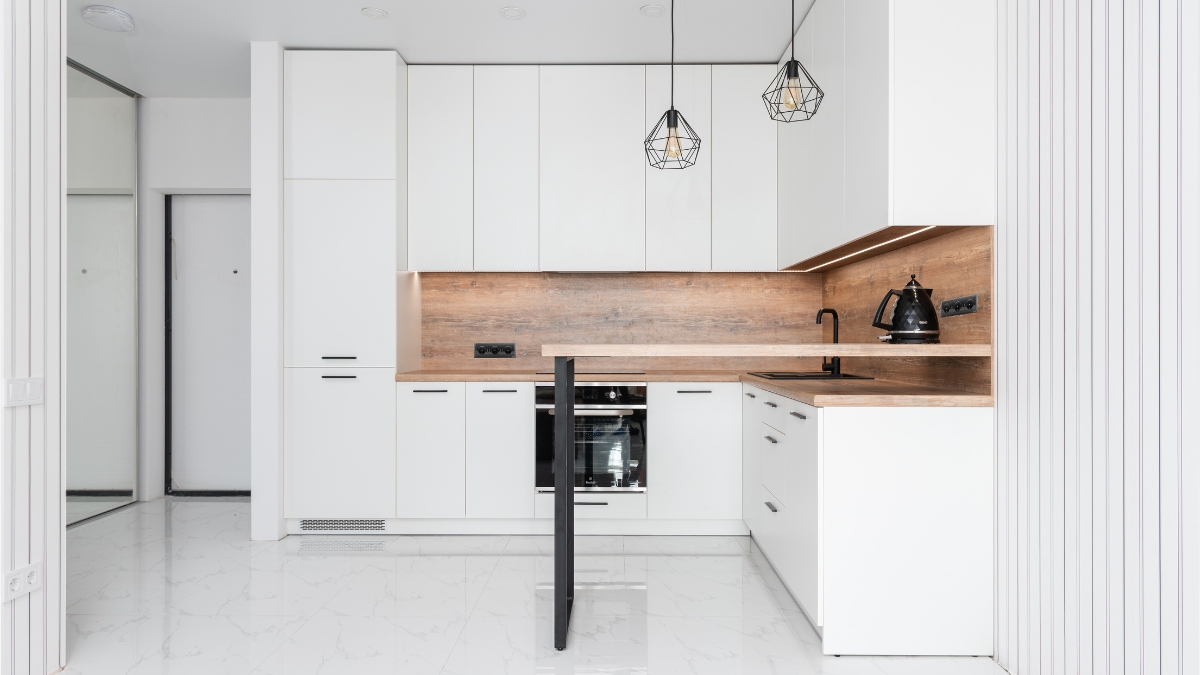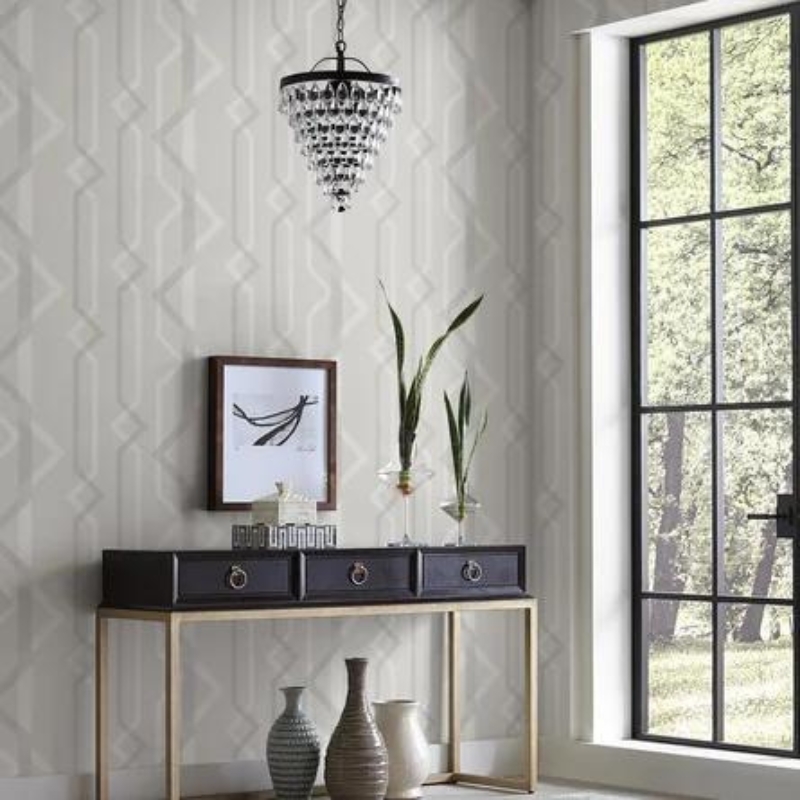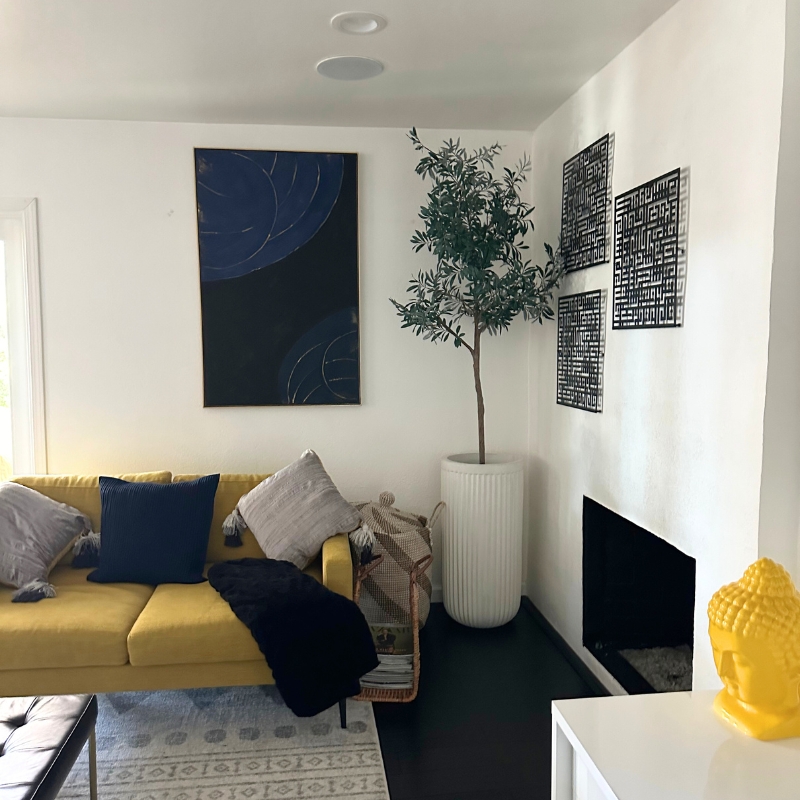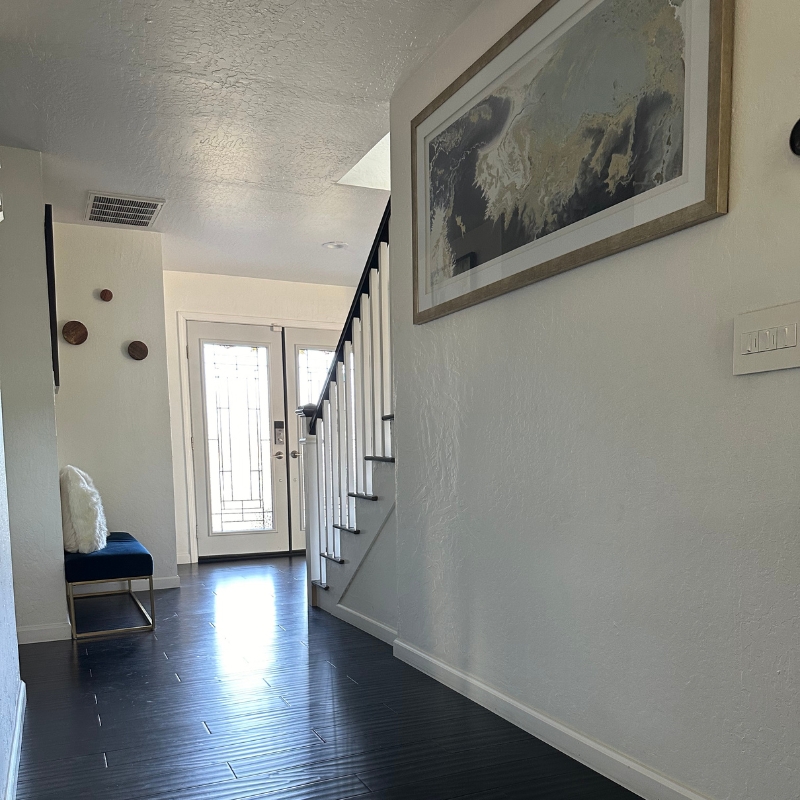Are envious of your friends new home build that has like 20 ft tall walls and you desperately want your older build homes to have the same tall ceiling vibe. In this post, we are sharing some tricks that can easily help you get that look without having to rebuild your home.
With a few simple decorating tricks, you can create the illusion of taller ceilings in your home. From paint choices to artwork placement, we’ve got all the tips you need to make your ceilings seem higher. Keep reading to learn how to transform your space and make those low ceilings a thing of the past.
Table of Contents
Why Trust Me?
We have fixed up two Californian ranch homes that were built around 1980s. These homes were built with 9 ft ceiling height and 10 ft ceiling height in the upper floor.
But we have managed to make our ceilings appear taller without any rearchitecting. And we are sharing these tricks with you.
Color Tricks to Elevate Your Ceiling
When dealing with low ceilings, utilizing color is a fundamental aspect of creating the illusion of height. The strategic use of lighter shades on the ceiling and walls, along with incorporating vertical stripes, can work wonders in making your cramped space feel more expansive and open.
Light Color Walls
Opting for light-colored walls can significantly contribute to the perception of a taller ceiling. Light hues such as soft blues, pale grays, and creamy off-whites have the ability to reflect more light, thereby producing a sense of airiness and spaciousness. This brightening effect extends upward, visually lifting the ceiling and granting the room a breezy, expansive feel.

The Power of Vertical Stripes
Incorporating vertical stripes, whether through wallpaper or paint, can be an effective optical trick for elongating the walls and drawing the eyes upward. These stripes create a sense of vertical movement, thereby visually increasing the height of the room. To maximize this effect, select subtle, tonal stripe patterns that seamlessly blend with the wall color, as bold or contrasting stripes may introduce visual clutter and detract from the desired outcome.
Lighting Solutions for a Lofty Feel
When it comes to making your low ceiling feel taller, lighting can play a crucial role. By strategically utilizing lighting solutions, you can create the illusion of a higher ceiling, making the space feel more open and airy.
Go for Recessed Lighting
Installing recessed lighting can be a game-changer for a room with a low ceiling. These fixtures are installed flush with the ceiling, eliminating the need for hanging or bulky lighting that can visually lower the ceiling height. Recessed lighting provides a sleek and modern look while effectively brightening the space without creating a cluttered feel.
The Magic of Upward Shining Lamps
Upward shining lamps have the ability to draw the eye upward, creating the illusion of a taller ceiling. By directing light towards the ceiling, these lamps bounce light off the ceiling and disperse it throughout the room, giving the impression of a more spacious and open area. Pairing upward shining lamps with dimmer switches can also provide flexibility in adjusting the light levels to suit different moods and activities.
Installing Wall Lights At the Right Height
If you want to add some wall scones or other wall lights, make sure that you are not adding it too low on the wall. It should be closer to the ceiling in proportion of the distance.
This gives an appearance of higher walls when you are looking at the space from a little farther. This is an easy hack to make your room look bigger and taller.
Furniture Choices That Create Illusions
When it comes to making short ceilings look taller, the furniture you choose plays a significant role in creating visual illusions of height. Here are some furniture choices that can help to create the illusion of higher ceilings:
Low-to-Ground Furniture
Opt for furniture that sits low to the ground. This creates the impression of more vertical space above the furniture, making the ceiling appear higher. Low-profile sofas, beds, and tables can help to open up the room and give the illusion of taller walls.
Slim and Non-bulky Furniture Pieces
Choose furniture that is slim and non-bulky. Bulky furniture can make a room feel cramped and the ceiling lower. Opt for streamlined pieces with slender legs and open bases, allowing more of the floor to be visible. This creates a sense of openness and airiness, making the ceiling appear higher.
So if you like those heavy lounge couches, they might be the reason your space looks cramped and small.
Strategic Decor to Enhance Ceiling Height
When dealing with low ceilings, strategic decor choices can create the illusion of greater vertical space. By employing visual tricks, you can make the ceiling appear taller and the room more expansive. Here are some effective tips:
Window Treatments That Reach for the Sky
Select window treatments that elongate the room by hanging them closer to the ceiling. This draws the eye upward and makes the room feel taller. Floor-to-ceiling curtains or drapes can create the perception of greater vertical space, especially when combined with sheer fabrics that allow light to penetrate, adding to the airy, heightened feel of the room.
While floor to ceiling curtains will do the trick, you also need them in a lighter shade complimenting the wall color. Opting for dark curtains will darken the entire space and make your space look small.
I know a lot of us love light blocking curtains and that is why we opt for dark window treatments. No need, go for blackout curtains in lighter shade. They do the same thing.
Use Shelves to Guide the Gaze Upwards
Strategically placed shelves draw the eye upward, making the ceiling appear taller. When adorned with carefully curated items, such as books or decorative pieces, they not only serve a practical purpose but also contribute to the perception of increased ceiling height. Open shelving can create an illusion of spaciousness and emphasize the vertical dimensions of the room.
Simple Crown Molding or No Molding
Another architectural consideration for addressing low ceilings is the use of crown molding or the deliberate absence of it. Simple, streamlined crown molding can help to visually extend the walls upwards and create a sense of elevation. Alternatively, for a more minimalist approach, opting for no molding at all can create clean lines that give the illusion of higher ceilings. This modern aesthetic can contribute to a more spacious and open feel within the room, effectively combating the limitations imposed by low ceiling height.
Smart Use of Mirrors
Tall Floor-length Mirrors
When it comes to making short ceilings appear taller, utilizing tall floor-length mirrors can be a game-changer. The elongated shape of these mirrors draws the eyes upward, creating an illusion of added height in the room. By reflecting both natural and artificial light, these mirrors also contribute to brightening up the space, further enhancing the perception of vertical space.
Placement Tips for Maximum Elevation
Strategic placement of mirrors is crucial for maximizing the visual impact of elongated mirrors. Positioning a floor-length mirror perpendicular to a window allows it to reflect the outdoor view, creating the impression of expanded space beyond the boundaries of the room. Placing the mirror directly across from a focal point, such as a fireplace or a piece of art, can also add depth and dimension to the room, effectively amplifying the sense of height.
Artwork Placement
Arranging artwork strategically can create the illusion of taller ceilings. By following specific guidelines for wall art placement, you can enhance your space and draw the eye upward, making your ceilings appear higher than they are. Here are some helpful tips for maximizing the impact of your wall art:
Tall Art Pieces on the Wall
Incorporate tall art pieces on the wall to draw the viewer’s gaze upwards, creating the illusion of higher ceilings. Vertical artworks, such as oversized paintings or tall framed prints, can accentuate the height of the room. By positioning these pieces at eye level and extending them towards the ceiling, you can visually elongate the walls, making the room feel more spacious and the ceilings appear taller.
Large Wall Art
Opt for large wall art to fill the vertical space and minimize the emphasis on the lower portions of the walls. A single substantial artwork or a curated arrangement of oversized pieces can divert attention from the ceiling’s lower perimeter, directing focus towards the expansive display. This approach shifts the visual balance upward, contributing to the perception of heightened ceilings within the room.
Minimal Use of Colors in Artwork
Select artworks with minimal color variation to promote a sense of continuity and airiness within the space. Limiting the color palette of the artwork can help create a seamless visual flow, reducing visual clutter and preventing the ceiling from feeling encroached upon. Subtle, monochromatic pieces or those with restrained color schemes can contribute to an unobtrusive backdrop, allowing the eye to ascend effortlessly, ultimately enhancing the perceived height of the ceilings.
Dark Floors
When it comes to making a room with a short ceiling appear taller, the type of flooring you choose can significantly impact the overall perception of space. Dark floors can either enhance or diminish the feeling of height in a room.
When you have darker floors and your walls and ceilings are lighter colored, the light reflects on the walls making them appear larger as the floor is becoming invisible.
This is one of the easiest way you a create an illusion of larger space.
Black floors are the best, but if you don’t like them, you can go for dark browns as well.
Floor To Ceiling Cabinets
Floor-to-ceiling cabinets draw the eyes upward, emphasizing the full height of the room. By capitalizing on the vertical space, these cabinets redirect attention from the lower ceiling, effectively tricking the eye into perceiving more height. The uninterrupted lines created by these tall units grant the impression of a loftier space, ultimately combating the low-ceiling conundrum.
Opting for floor-to-ceiling cabinetry generates a seamless, unbroken look, eliminating the visual disruptions caused by shorter cabinets or open space above them. This cohesive aesthetic not only contributes to the perception of increased ceiling height but also lends a modern and polished feel to the room. The absence of gaps or visible breaks in the cabinetry creates a clean, uncluttered environment, fostering an illusion of spaciousness.

Lighter Color Tall Cabinets
When dealing with a space with low ceilings, choosing lighter color tall cabinets can significantly influence how spacious and airy the room appears. Lighter hues have the ability to reflect light, creating an illusion of height and openness. By opting for tall cabinets in shades like soft white, light gray, or pale cream, you can draw the eye upward, making the ceiling appear higher than it actually is.
Tall cabinets not only provide ample storage but also draw attention upward. By incorporating floor-to-ceiling cabinets in a lighter color, you can make the most of the vertical space, inadvertently diverting the gaze away from the low ceiling. This approach creates an impression of elevated ceilings and a more expansive room.

If you have any questions, don’t forget to leave a comment.









